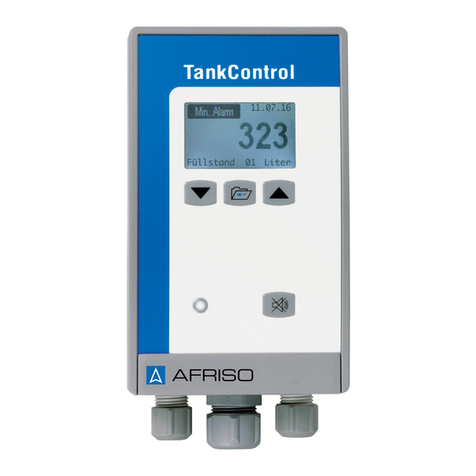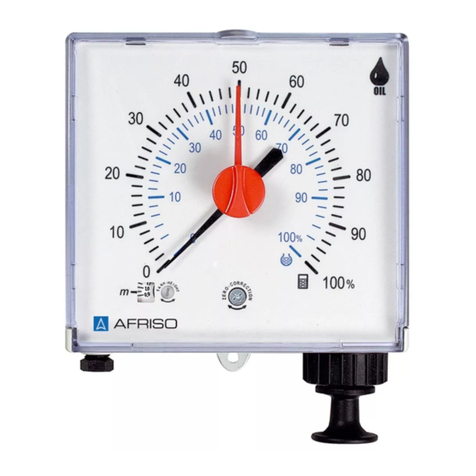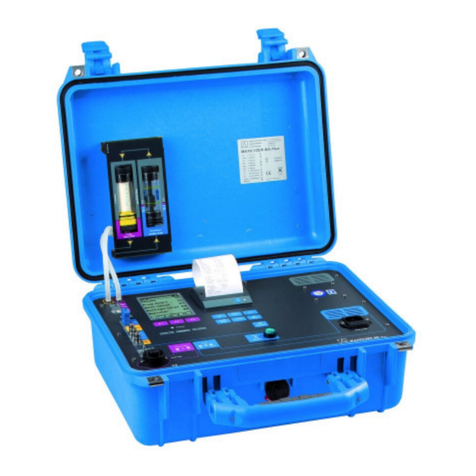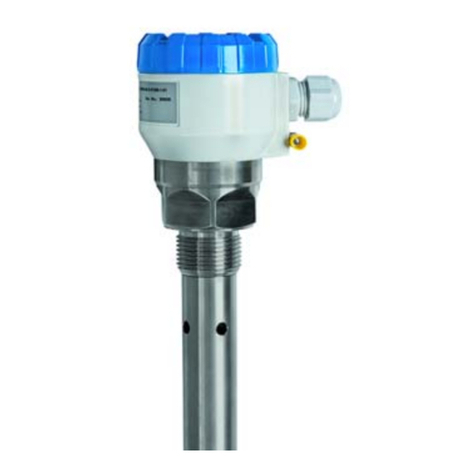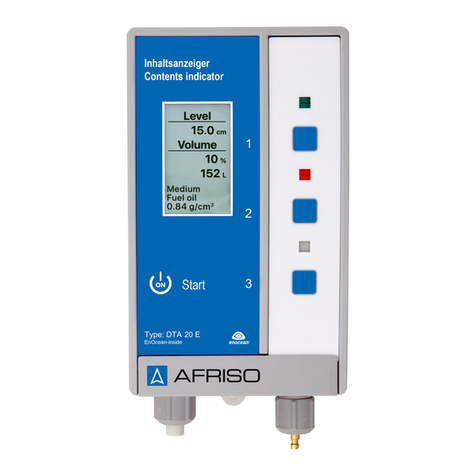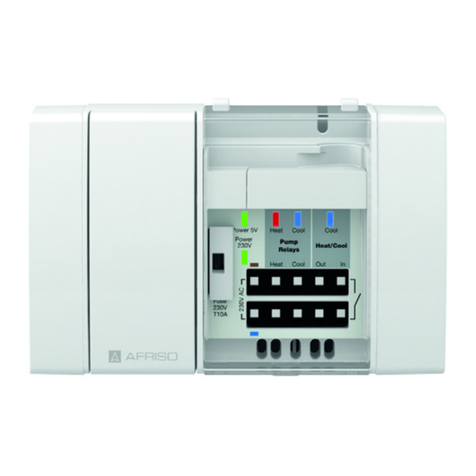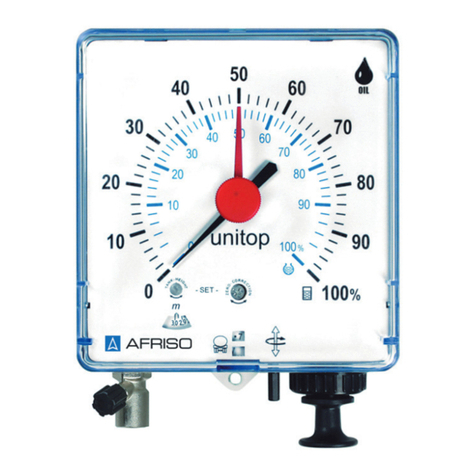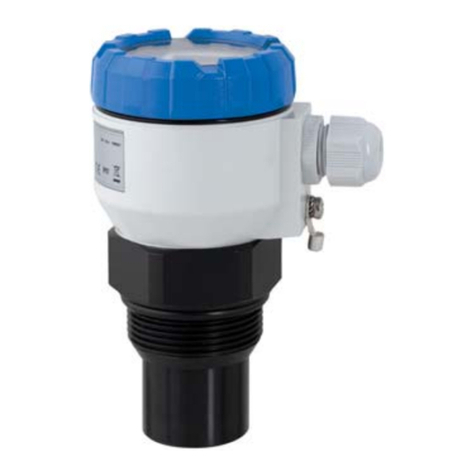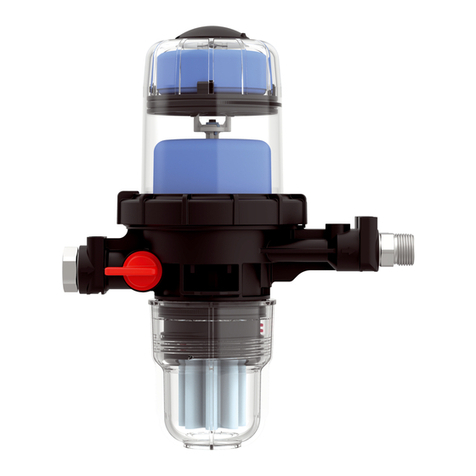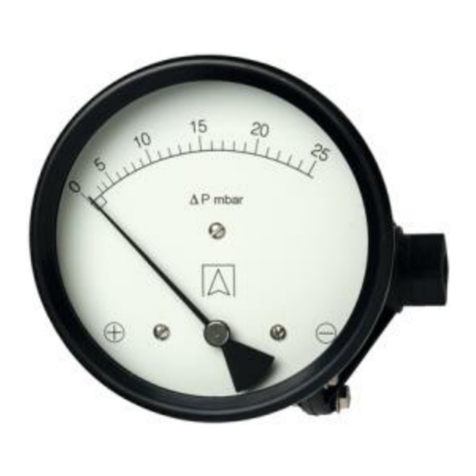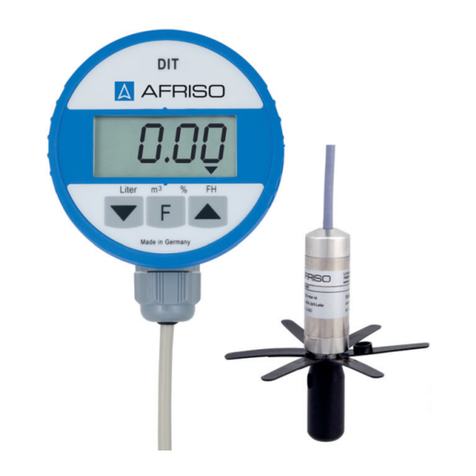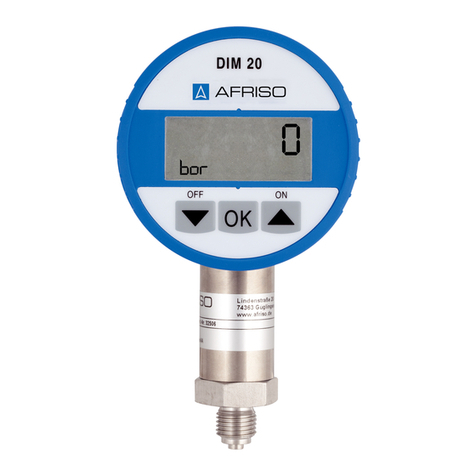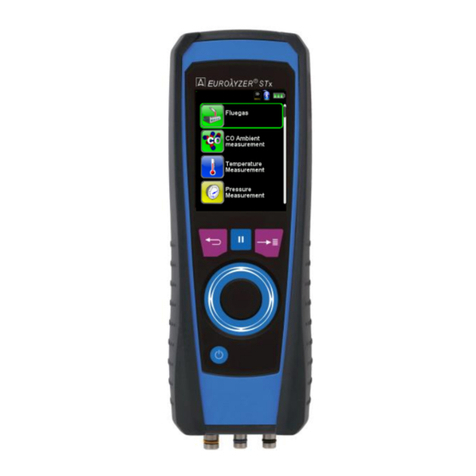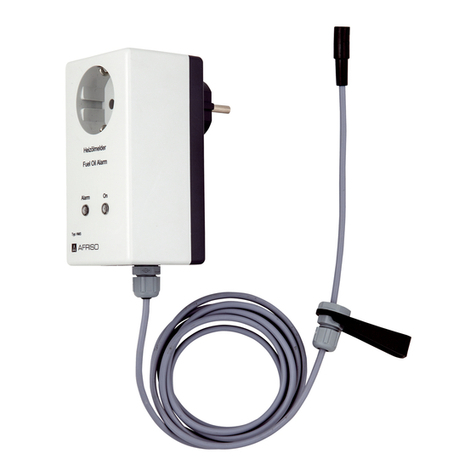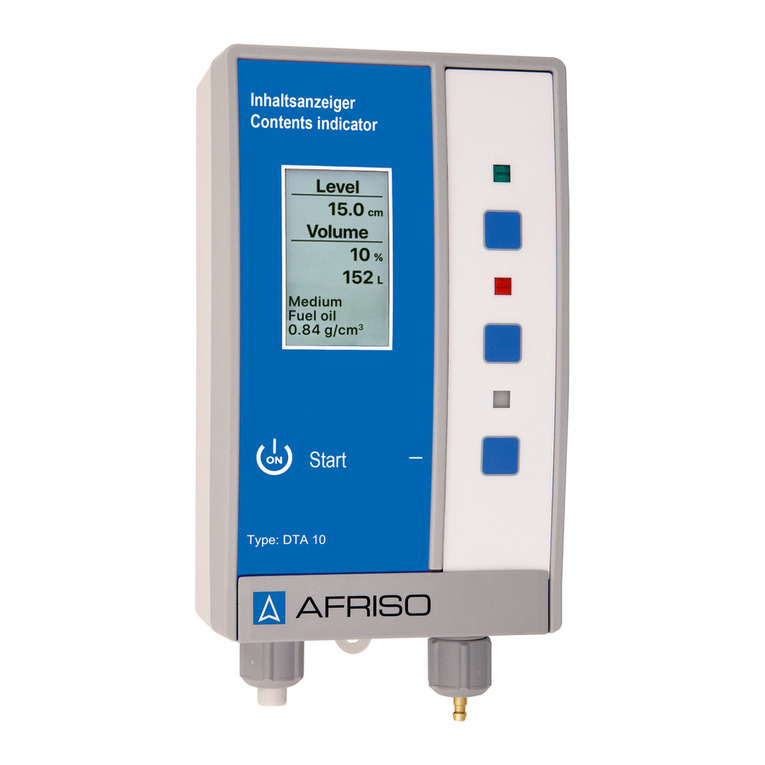
© 2021 AFRISO-EURO-INDEX GmbH –
All rights reserved.
Lindenstraße 20
Operating instructions 74363 Güglingen
Fon: +49 7135 102-0
Service: +49 7135 102-211
info@afriso.com
probes www.afriso.com
DMU 08, DMU 08 T, DMU 09
ID: 900.100.0832 Version: 10.2021.0
1. General and Safety-Related Information on
this Operating Manual
This operating manual enables safe and proper
handling of the product.
This operating manual forms part of the device and
should be kept in close proximity to the place of use,
accessible for staff members at any time.
All persons entrusted with the mounting, installation,
putting into service, operation, maintenance,
removal from service, and disposal of the device
must have read and understood the operating
manual and in particular the safety-related
information.
The following documents are an important part
of the operating manual:
- Data sheet
For specific data on the individual sensors, please
refer to the respective data sheet.
Download these by accessing www.afriso.com or
In addition, the applicable accident prevention
regulations, safety requirements, and country-
specific installation standards as well as the
accepted engineering standards must be observed.
1.1 Symbols Used
- Type and source of danger
- Measures to avoid the
danger
Warning word Meaning
DANGER
- Imminent danger!
- Non-compliance will
result in death or serious
injury.
WARNING
- Possible danger!
- Non-compliance may
result in death or serious
injury.
CAUTION
- Hazardous situation!
- Non-compliance may result
in minor or moderate injury.
– draws attention to a possibly hazardous
situation that may result in property damage in case
of non
-compliance.
Precondition of an action
1.2 Staff Qualification
Qualified persons are persons that are familiar with
the mounting, installation, putting into service,
operation, maintenance, removal from service, and
disposal of the product, and have the appropriate
qualification for their activity.
This includes persons that meet at least one of the
following three requirements:
- They know the safety concepts of
metrology and automation technology and
are familiar therewith as project staff.
- They are operating staff of the measuring
and automation systems and have been
instructed in the handling of the systems.
They are familiar with the operation of the
devices and technologies described in this
documentation.
- They are commissioning specialists or are
employed in the service department, and
have completed training that qualifies
them for the repair of the system. In
addition, they are authorized to put into
operation, to ground, and to mark circuits
and devices according to the safety
engineering standards.
All work with this product must be carried out by
qualified persons!
1.3 Intended Use
The probes are exclusively suitable for continuous
hydrostatic filling-level measurement.
The user must check whether the device is suited
for the selected use. In case of doubt, please
contact our sales department (info@afriso.com).
AFRISO assumes no liability for any wrong selection
and the consequences thereof!
The fluids that can be measured are liquids that are
compatible with the materials in contact with the
fluids, described in the data sheet. For application, it
must additionally be ensured that the fluid is
compatible with the parts in contact with the fluid.
The specifications listed in the current data sheet
are binding and must absolutely be complied with. If
you do not have the data sheet to hand, please
request it or download it from our homepage.
(http://www.afriso.de)
1.4 Limitation of Liability and Warranty
Failure to observe the instructions or technical
regulations, improper use and use not as intended,
and alteration of or damage to the device will result
in the forfeiture of warranty and liability claims.
1.5 Safe Handling
NOTE – Treat the device with care both in the
packed and unpacked condition!
NOTE – The device must not be altered or modified
in any way.
NOTE – Do not throw or drop the device!
NOTE – Excessive dust accumulation (over 5 mm)
and complete coverage with dust must be
prevented!
The device is state-of-the-art and is operationally
reliable. Residual hazards may originate from the
device if it is used or operated improperly.
1.6 Packaging Content
Check that all parts listed in the scope of delivery
are included free of damage, and have been
delivered according to your purchase order:
- probe
- operating manual
2. Product Identification
The device can be identified by means of the type
plate with order code. The most important data can
be gathered therefrom.
1Type designation 4Order code
2Input 5Terminal assignment
3Output 6Serial number
Fig. 1: Type plate
NOTE – The type plate must not be removed!
3. Mounting
3.1 Mounting and Safety Instructions
WARNING
- airborne parts, leaking fluid,
electric shock
- Always mount the device in a
depressurized and de-
energized condition!
NOTE – If there is increased risk of damage to the
device by lightning strike or overvoltage, increased
lightning protection must additionally be provided!
NOTE – Install the probe such that any rubbing or
bumping of the sensor head (sensor element), e.g.
against a container wall, is excluded. Observe the
operating conditions such as, for example, flow
conditions. This applies in particular to probes
equipped with cable outlet and to devices with tube
extensions of a length over 2.8 m.
NOTE – Do not remove the packaging or protective
caps of the device until shortly before the mounting
procedure, in order to exclude any damage to the
diaphragm and the threads!
Protective caps must be kept! Dispose of the
packaging properly!
NOTE – Treat any unprotected diaphragm with
utmost care; this can be damaged very easily.
3.2 Mounting Steps for Probes
NOTE – Always immerse the device slowly into the
fluid to be measured! If the probe strikes the liquid
surface, the diaphragm could be damaged or
destroyed.
NOTE – Fasten the probe properly according to your
requirements.
NOTE –Free-hanging probes with FEP cables
should not be used if effects of highly charging
processes can be expected.
As standard, the probe is supplied without fastening
material. Clamp fixing, anchor clamp and mounting
flanges are available as accessories, for different
mounting variants.
3.3 Mounting Steps for fitting set
The mounting thread is clean and undamaged
The O-ring is undamaged and seated in the
designated groove
1. Assemble suitable parts according to demands.
2. Conduct the Cable by the PG11 screw
connection. Note the submersion depth in the
container.
3. Then tighten the single parts of the fitting set by
hand.
If you need a fitting set, this can be ordered from
AFRISO as an accessory (Art. No. 52125).
3.4 Removal of Protective Cap (if equipped)
The probes are equipped with a plastic protective
cap to protect the diaphragm. This has to be pulled
off prior to putting into service if the probe is to be
used in a higher viscous fluid such as sludge. This
makes the probe front-flush, and the fluid reaches
the diaphragm.
Removal by hand
1. Hold the probe such that the protective cap
points upward.
2. Hold the probe with one hand on the probe
section
(Fig. 2 – 1).
3. Pull off the protective cap (Fig. 2 – 2) with the
other hand.
Removal using a tool (recommended)
1. Hold the probe such that the protective cap
points upward.
2. Slide a thin tool (Fig. 2 – 8), e.g. a screwdriver,
through two opposite bores of the protective cap
(Fig. 2 – 2).
3. Lever off the protective cap.
NOTE –Do not damage the measuring cell (Fig. 2 –
7) under the protective cap!
3.5 Cable Protection (Optional)
According to order, the probe was supplied with
cable protection; if the probe was prepared for
mounting by means of a stainless steel or PVC tube
(optional), the customer must affix a cable protection
themselves.
Fig. 3: Cable protection variants
4. Electrical Connection
4.1 Connection and Safety Instructions
WARNING
-
Improper installation may result
in electric shock
- Always mount the device in a
depressurized and de-
DANGER
- Explosion hazard if the
operating voltage is too high
(max. 28VDC)!
- Operate the device only within
the specification! (data sheet)
The limit values listed in the EC type-
examination certificate are observed.
(Capacity and inductance of the connection
cable are not included in the values.)
The supply corresponds to protection class II.
(protective insulation)
NOTE – for devices with cable outlet
- When routing the cable, the following minimum
bend radii must be observed:
Cable without air hose:
fixed installation: 5-fold cable diameter
flexible use: 10-fold cable diameter
Cable with air hose:
fixed installation: 10-fold cable diameter
flexible use: 20-fold cable diameter
- In case of devices with cable outlet and
integrated ventilation hose, the PTFE filter
located at the cable end on the relative pressure
hose must neither be damaged nor removed!
NOTE –Use a shielded and twisted multicore cable
for the electrical connection.
NOTE –If a transition is desired from a cable with
relative pressure hose to a cable without relative
pressure hose, we recommend using the terminal
box with pressure equalizing port (Art. No. 31824).
4.2 Electrical Installation
Connect the device electrically according to the
information specified on the type plate, the following
table, and the connection circuit diagram.
Terminal assignment table:
wh (white)
DMU 08 T
Supply P–
Supply T+
bn (brown)
gy (gray)
Connection circuit diagrams:
2-wire system (power)
2x2-wire-system (current) (DMU 08 T)
NOTE –In the case of relative pressure gauges, the
cable contains a ventilation hose for pressure
equalization. Route the end of the cable into an area
or suitable connection box which is as dry as
possible and free from aggressive gases, in order to
prevent any damage
S
I
Fig. 2: Removal of protective cap
Examples for cable protection
with stainless steel tube
steel
corrugated
steel or PVC
tube
supply
VS
p
S
–
